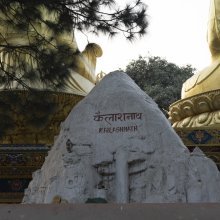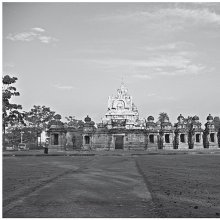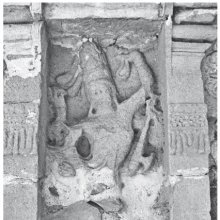Kailasanatha, Kailāsanātha, Kailāśanātha, Kailasa-natha: 5 definitions
Introduction:
Kailasanatha means something in Hinduism, Sanskrit, the history of ancient India. If you want to know the exact meaning, history, etymology or English translation of this term then check out the descriptions on this page. Add your comment or reference to a book if you want to contribute to this summary article.
The Sanskrit term Kailāśanātha can be transliterated into English as Kailasanatha or Kailashanatha, using the IAST transliteration scheme (?).
Images (photo gallery)
(+240 more images available)
In Hinduism
Vastushastra (architecture)
Source: Shodhganga: Temples of Salem region Up to 1336 ADKailāsanātha (कैलासनाथ).—This temple is a very good example for the hybridization of the Chola idiom and the Hoysala idiom. The main shrine of this temple was constructed during the rule of Hoysala king Ramanatha deva, prior to 1268 A.D. Even this temple is built in three phases. The main shrine was probably consecrated in the mid 13th century. Surrounding this shrine, a prākara was built in the 16th century. The construction of the second prākāra is a few decades later than that of the first prākāra. Though this temple is of Chola Dravida style, the ornamentation and decoration of the architectural members extensively reflect the influence of the Hoysala school of art.

Vastushastra (वास्तुशास्त्र, vāstuśāstra) refers to the ancient Indian science (shastra) of architecture (vastu), dealing with topics such architecture, sculpture, town-building, fort building and various other constructions. Vastu also deals with the philosophy of the architectural relation with the cosmic universe.
Shaivism (Shaiva philosophy)
Source: Wisdom Library: ŚaivismKailāśanātha is the name of one of the eighteen Siddhars mentioned in the Abhidāna-cintāmaṇi, a 12th century lexicon by Hemacandra. The Siddhars refers to ancient intellectuals of Tamil Nadu and are the teachers of Siddha medicine: an ancient practice of South-India claiming to over 8,000 years old.
According to tradition, Nandi and Agastya learnt the Siddha system of medicine and Śivayoga from Śiva, and imparted it to a number of disciples (eg., Kailāśanātha). These Siddhars are united by their philosophy, accepting the human body as the microcosm of the universe, and seeing the human evolution as the ultimate accomplishment of the regenerative power of the Universe.

Shaiva (शैव, śaiva) or Shaivism (śaivism) represents a tradition of Hinduism worshiping Shiva as the supreme being. Closely related to Shaktism, Shaiva literature includes a range of scriptures, including Tantras, while the root of this tradition may be traced back to the ancient Vedas.
India history and geography
Source: Shodhganga: The significance of the mūla-beras (history)Kailasanatha temple was built by Narasimhavarman II (AD 695–722): a king from the Pallava dynasty.—The great monuments at Mahabalipuram are a tribute to the eternal glory of Narasimhavarman I (AD 630-668). He was the son of Mahendravarman I (AD 600-630) and is known as Māmalla. Narasimhavarman II, also called Rajasimha, built the Kailasanatha Temple at Kanchipuram, a fine example of early Pallava masonry work. Nandivarman II (AD 730-795) was responsible for the other famous shrine Vaikuntaperumal Temple at Kanchipuram. Thus the high period of the Pallava style came between AD 600 and 800.

The history of India traces the identification of countries, villages, towns and other regions of India, as well as mythology, zoology, royal dynasties, rulers, tribes, local festivities and traditions and regional languages. Ancient India enjoyed religious freedom and encourages the path of Dharma, a concept common to Buddhism, Hinduism, and Jainism.
Languages of India and abroad
Sanskrit dictionary
Source: Cologne Digital Sanskrit Dictionaries: Monier-Williams Sanskrit-English DictionaryKailāsanātha (कैलासनाथ):—[=kailāsa-nātha] [from kailāsa] m. ‘sovereign of the Kailāsa mountain’, Name of Kubera, [Vikramorvaśī; Raghuvaṃśa v, 28.]
[Sanskrit to German]
Sanskrit, also spelled संस्कृतम् (saṃskṛtam), is an ancient language of India commonly seen as the grandmother of the Indo-European language family (even English!). Closely allied with Prakrit and Pali, Sanskrit is more exhaustive in both grammar and terms and has the most extensive collection of literature in the world, greatly surpassing its sister-languages Greek and Latin.
See also (Relevant definitions)
Partial matches: Kailasa, Natha.
Starts with: Kailacanatan, Kailasanathar Temple.
Full-text: Kailasaniketanatha, Kailasaniketana, Kailasanathar Temple, Irumbarai, Kayilayanatan, Nalvar, Taramanagalam, Vyaghrapada, Narasimhavarman, Mamalla, Vaikuntaperumal, Rajasimha, Nandivarman, Sambhavana, Patanjali, Citra, Talasamsphotita, Kailasa.
Relevant text
Search found 14 books and stories containing Kailasanatha, Kailāsanātha, Kailāśanātha, Kailasa-natha, Kailāśa-nātha, Kailasha-natha, Kailāsa-nātha; (plurals include: Kailasanathas, Kailāsanāthas, Kailāśanāthas, nathas, nāthas). You can also click to the full overview containing English textual excerpts. Below are direct links for the most relevant articles:
Vastu-shastra (5): Temple Architecture (by D. N. Shukla)
Kailāśa-nātha and Vaikuṇṭha Perumal < [Chapter 12 - History of Hindu Temples (Prāsādas and Vimānas)]
Bhaumika Vimānas (Temples of South India, Decan and Greater India) < [Chapter 12 - History of Hindu Temples (Prāsādas and Vimānas)]
Pallava Phase (Circa 600 A.D. to 900) < [Chapter 12 - History of Hindu Temples (Prāsādas and Vimānas)]
Pallava period (Social and Cultural History) (by S. Krishnamurthy)
Ornamental Diagonal Band across the Body < [Chapter 4 - Material Culture of the People]
Leg Ornaments < [Chapter 4 - Material Culture of the People]
Solid instruments (Ghana) < [Chapter 4 - Material Culture of the People]
The Religion and Philosophy of Tevaram (Thevaram) (by M. A. Dorai Rangaswamy)
Chapter 2.3 - Partha-anugraha-murti (depiction of the story of Arjuna) < [Volume 2 - Nampi Arurar and Mythology]
Introduction to second volume < [Volume 2 - Nampi Arurar and Mythology]
Symbology of khatvanga in the Mahavrata < [Volume 2 - Nampi Arurar and Mythology]
Temples of Munnur (Historical Study) (by R. Muthuraman)
Middle Chola Temples (by S. R. Balasubrahmanyam)
Temples in Brahmadesam < [Chapter II - Temples of Rajaraja I’s Time]
The Central Shrine < [Tanjavur/Thanjavur (Rajarajesvaram temple)]
Later Chola Temples (by S. R. Balasubrahmanyam)
Temples in Arumbavur < [Chapter XIV - Temples of Rajaraja III’s Time]
Temples in Laddigam < [Chapter II - Temples of Kulottunga I’s Time]
Related products






